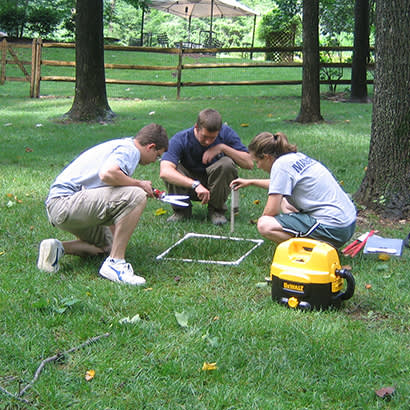
Understanding metropolitan Baltimore as a living, ecological system
How do humans and nature interact in cities? How do social, political and economic factors shape the urban environment? And, how do urban areas challenge our thinking about what is natural? These questions are becoming increasingly important, as the number of people living in cities grows every year. Currently, the 50 largest cities in the United States account for more than 50 percent of the total population, and the growth of cities is projected to continue for the foreseeable future.
Every day, examples of how intertwined people are with their environment are evident, even in densely developed cities where not much nature seems to be left. We see it in places like Ellicott City, Maryland, only 10 miles outside of Baltimore, which was devastated by two “1,000-year floods” within two years, the result of a quickly overdeveloped watershed or stories like that of P-22, the mountain lion that has taken up residence below the famous Hollywood sign in Griffith Park. There is a clear need for a more nuanced understanding of the reciprocal relationships that influence urban environments; yet, very few cities have long-term data on how the complex interactions between people and nature have changed over time. But, Baltimore, host city for the 2019 NRPA Annual Conference, is one of the best understood urban ecosystems in the world.
Some Baltimore Ecosystem Study Findings
In 1980, the National Science Foundation (NSF) funded research programs at 28 sites, the first Long-Term Ecological Research (LTER) sites, to provide a longer view to support ecological discovery on the influence of long-term and large-scale phenomenon. Each LTER site involves dozens of researchers and typically includes microbial, community and landscape ecologists, as well as hydrologists, geochemists, social scientists, economists and even the occasional artist, historian or philosopher. The shared knowledge of place offers unusual common ground for exploring disciplinary intersections.
The Baltimore Ecosystem Study (BES) is a groundbreaking urban ecology research project that launched in 1997 and, 22 years later, is still collecting a tremendous amount of data and producing novel and important research. As one of the NSF’s 28 LTER sites, the BES aims to understand the city as a living, ecological system and has brought together researchers from across the country to investigate the unique urban aspect on topics as varied as hydrology, biology, geography, environmental justice, epidemiology and environmental chemistry. Over the past two decades, this work has resulted in dozens of findings that have reshaped the way nature — and parks — are perceived in urban areas around the world.
One of the misconceptions the BES has helped to upend is the association of crime with natural areas in cities. Natural areas in cities, especially in neighborhoods with higher levels of criminal activity, have often been decried as hot spots for nefarious behavior. However, in 2012, a group of researchers found that the presence of street trees correlated with lower rates of crime in some of West Baltimore’s most economically depressed neighborhoods. Even when controlling for a variety of other socioeconomic factors, the research pointed to the presence of trees as a significant factor in the reduction in criminal behavior. Subsequent studies in 2015 and 2016, found that people living in communities with greater tree cover felt a deeper connection with their neighbors and that well-maintained yards are associated with lower levels of crime, again while controlling for other factors.
While nature can improve the quality of life in neighborhoods, the BES has also found that historical formal and informal practices of racial discrimination, such as segregation and “redlining,” — the practice of denying access to financial services and products, such as mortgages to majority-black, inner-city neighborhoods — led to environmental injustices. These injustices, such as urban heat islands and lack of access to park and recreation facilities, continue to this day.
In addition to showing the benefits of natural features to the safety of Baltimore’s poorest neighborhoods, the BES found that concern for the environment is widely held by residents across the city and across a wide range of income. A survey of Baltimore residents’ views on the environment revealed that both low- and high-income and rich neighborhoods cared about their natural environment, especially regarding the connection between the environment and health.
The BES has also uncovered surprisingly rich biodiversity within the city, challenging the common perception of cities as ecologically destructive areas dominated by exotic and invasive species. While the speed and scale of urbanization has a net negative impact on global biodiversity, individual urban areas yield a surprising amount of biodiversity within the city. Looking across studies done to assess diversity in plant, insect and bird communities, researchers found native species across the city and, in many cases, native species are more dominant than non-native ones. Perhaps, surprisingly, exotic species are not always a threat to native ones. They can, for instance, support robust native pollinator populations, and invasive earthworms are an important food source for native bird populations.
More information on the BES can be found at the BES website. The 22 years of research this study has provided, offers us not only an abundance of resources and tools to create and maintain better natural spaces in cities, but also sound scientific arguments for the value parks provide to communities across the socioeconomic spectrum.
Karl Schrass is NRPA's Director of Conservation.

